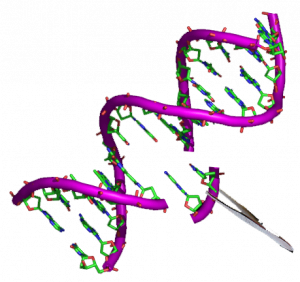Description
Genetic engineering is the manipulation, modification, and artificial recombination of DNA or other nucleic acid molecules to modify an organism or a population of organisms. The term genetic engineering is generally used to refer to methods of recombinant DNA technology, which grew out of basic research in microbial genetics. The techniques used in genetic engineering have led to the production of medically important products, such as human insulin, human growth hormone, and the hepatitis B vaccine, as well as the development of genetically modified organisms, such as disease-resistant plants.
Process and techniques
Most recombinant DNA technology involves the insertion of foreign genes into the plasmids of common laboratory strains of bacteria. Plasmids are small rings of DNA; they are not part of the bacteria’s chromosome (the organism’s main repository of genetic information). However, they are capable of directing protein synthesis and, like chromosomal DNA, they reproduce and pass on to the bacterial progeny. Therefore, by incorporating foreign DNA (for example, a mammalian gene) into a bacterium, researchers can obtain an almost unlimited number of copies of the inserted gene.
Furthermore, if the inserted gene is functional (ie directs protein synthesis), the modified bacterium will produce the protein specified by the foreign DNA. A later generation of genetic engineering techniques that emerged in the early 21st century focused on gene editing. Gene editing, based on a technology known as CRISPR-Cas9, allows researchers to customize the genetic sequence of a living organism by making very specific changes to its DNA. Gene editing has a wide range of applications, being used for the genetic modification of crop plants and livestock and of laboratory model organisms (eg mice).

The correction of genetic errors associated with diseases in animals suggests that gene editing has potential applications in gene therapy for humans. Gene therapy is the introduction of a normal gene into an individual’s genome to repair a mutation that causes a genetic disease. When a normal gene is inserted into a mutant nucleus, it will most likely integrate into a different chromosomal site than the defective allele; although this can repair the mutation, a new mutation can result if the normal gene integrates into another functional gene. If the normal gene replaces the mutant allele, there is a chance that the transformed cells will proliferate and produce enough of the normal gene product for the entire body to revert to the healthy phenotype.
Applications
Genetic engineering has advanced the understanding of many theoretical and practical aspects of gene function and organization. Through recombinant DNA techniques, bacteria have been created that are capable of synthesizing human insulin, human growth hormone, interferon-alpha, a hepatitis B vaccine, and other medically useful substances. Plants can be genetically adjusted to allow them to fix nitrogen, and genetic diseases can possibly be corrected by replacing dysfunctional genes with genes that function normally.
Genes for insect-killing toxins have been introduced into several plant species, including corn and cotton. Bacterial genes that confer herbicide resistance have also been introduced into crop plants. Other attempts at genetic engineering of plants have been aimed at improving the nutritional value of the plant.

